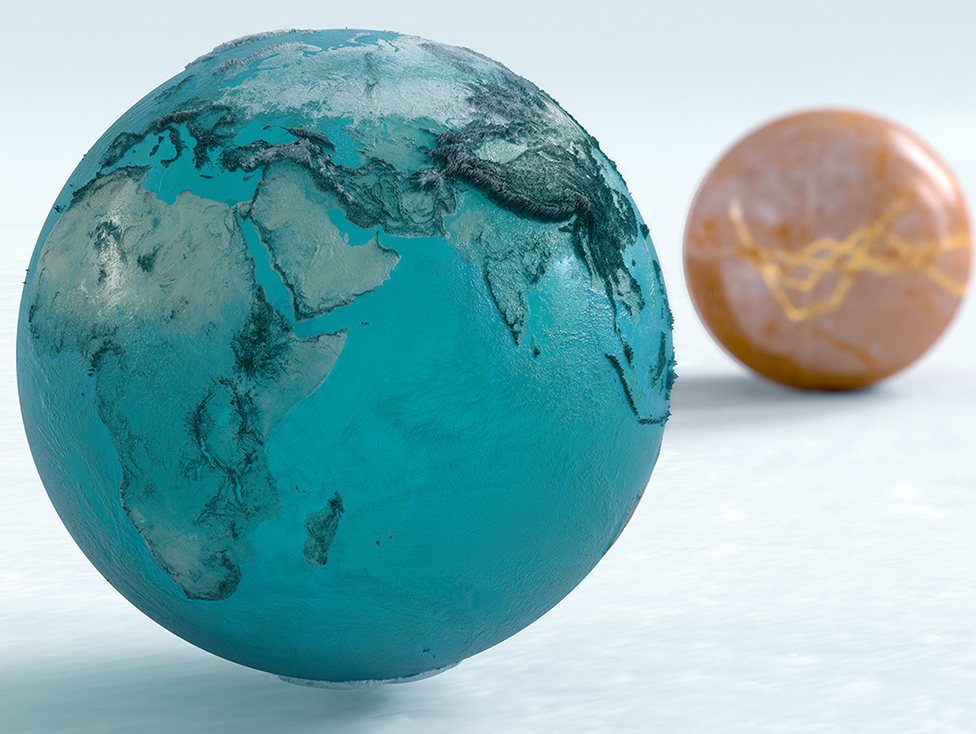- Article

- Global Research
- General Research Insights
- Emerging markets
Asia-Middle East Corridor
Revisiting the Southern Silk Road
- Economic connectivity between Asia and the Middle East is set to soar in coming years, expanding well beyond energy trade
- Annual two-way goods trade is projected to more than double from around USD950bn in 2022 to over USD1.9trn by 2035
- Two-way investment, led by the China-Saudi and India-UAE corridors, could surge to USD36bn annually by 2035
Beyond energy. The Gulf countries and Egypt sit on over a quarter of global crude oil reserves, while Asia is home to the world’s largest oil importer and a growing giant in India. Besides energy, the two regions also complement each other in many areas of trade, investment, and people exchange. And perhaps most importantly, the major economies on both sides are still committed to opening to the world. The Asia–Middle East trade, investment, and travel corridor, in other words, is set to thrive.


Trade integration. Asia is a critical export market for the Middle East. Over half of Qatari and Saudi exports, mostly crude oil and LNG, went to Asia in 2022. Although energy is the foundation of Asia–Middle East trade, many other products—from Saudi plastics to Indian pharmaceuticals—are rapidly gaining. More trade deals between the Gulf Cooperation Council and Asian partners—such as China, India, and Japan—would further bolster inter-regional trade. Asia–Middle East goods trade totalled cUSD954bn in 2022 and our projections suggest this figure could balloon to USD1.9trn by 2035. For reference, US-China trade in 2022 only totalled around USD750bn.
USD 954bn
Approximate Asia–Middle East goods trade total in 2022
USD 1.9trn
Estimated Asia–Middle East goods trade total in 2035
Investment integration. Northeast Asian investors are increasingly pouring funds into the Middle East, with flows in the opposite direction also rising. A key corridor is also emerging between the UAE and India, which recorded USD6bn of FDI in 2022 that we estimate could rise to USD14bn annually by 2035. Indian digital services are an especially promising sector for UAE investors. More broadly, cumulative FDI flows between Asia and the Middle East are expected to total over USD270bn over the next 10 years, up from less than USD140bn the previous decade. For China, renewing momentum in BRI projects in the Middle East region and further RMB internationalisation will require strong Saudi support. Meanwhile, Middle East investment projects in ASEAN are quietly expanding to cover a wide range of sectors.


People integration. Inter-regional tourism took a significant hit during the Covid-19 pandemic, but travel is slowly recovering. Boosting Chinese and Indian visitor numbers will be critical for the Middle East’s tourism industry, while Southeast Asian tourism markets—such as Thailand, Indonesia, and Malaysia—look for the return of high-income Saudi and UAE visitors. Overseas remittances are another important aspect of people integration, particularly for Bangladesh, Sri Lanka, and the Philippines.
Our conclusion? Economic connectivity between Asia and the Middle East is set to soar in coming years, expanding well beyond energy to encompass other forms of goods trade, financial investment, and people-to-people exchange. It has the potential to be a beacon of connectivity even as protectionist arguments grow louder in other parts of the world.
Would you like know more? Click here* to read the free to view report.
To find out more about HSBC Global Research, and how to subscribe, please email AskResearch@hsbc.com.
* Please note that by clicking on this link you are leaving the HSBC Global Banking & Markets Website, therefore please be aware that the external site policies will differ from our website terms and conditions and privacy policy. The next site will open in a new browser window or tab.
Global Research
HSBC Global Research provides information, insights and thought-provoking ideas.

The following analyst(s), who is(are) primarily responsible for this document, certifies(y) that the opinion(s), views or forecasts expressed herein accurately reflect their personal view(s) and that no part of their compensation was, is or will be directly or indirectly related to the specific recommendation(s) or views contained in this research report: Simon Williams, Frederic Neumann, Justin Feng and Shanella Rajanayagam
This document has been issued by the Research Department of HSBC.
HSBC and its affiliates will from time to time sell to and buy from customers the securities/instruments, both equity and debt (including derivatives) of companies covered in HSBC Research on a principal or agency basis or act as a market maker or liquidity provider in the securities/instruments mentioned in this report.
Analysts, economists, and strategists are paid in part by reference to the profitability of HSBC which includes investment banking, sales & trading, and principal trading revenues.
Whether, or in what time frame, an update of this analysis will be published is not determined in advance.
For disclosures in respect of any company mentioned in this report, please see the most recently published report on that company available at www.hsbcnet.com/research.
Additional disclosures
- This report is dated as at 02 May 2024.
- All market data included in this report are dated as at close 01 May 2024, unless a different date and/or a specific time of day is indicated in the report.
- HSBC has procedures in place to identify and manage any potential conflicts of interest that arise in connection with its Research business. HSBC's analysts and its other staff who are involved in the preparation and dissemination of Research operate and have a management reporting line independent of HSBC's Investment Banking business. Information Barrier procedures are in place between the Investment Banking, Principal Trading, and Research businesses to ensure that any confidential and/or price sensitive information is handled in an appropriate manner.
- You are not permitted to use, for reference, any data in this document for the purpose of (i) determining the interest payable, or other sums due, under loan agreements or under other financial contracts or instruments, (ii) determining the price at which a financial instrument may be bought or sold or traded or redeemed, or the value of a financial instrument, and/or (iii) measuring the performance of a financial instrument or of an investment fund.
This document has been issued by HSBC Bank Middle East Ltd, DIFC, which has based this document on information obtained from sources it believes to be reliable but which it has not independently verified. Neither HSBC Bank Middle East Ltd, DIFC nor any member of its group companies (“HSBC”) make any guarantee, representation or warranty nor accept any responsibility or liability as to the accuracy or completeness of this document and is not responsible for errors of transmission of factual or analytical data, nor is HSBC liable for damages arising out of any person’s reliance on this information. The information and opinions contained within the report are based upon publicly available information at the time of publication, represent the present judgment of HSBC and are subject to change without notice.
This document is not and should not be construed as an offer to sell or solicitation of an offer to purchase or subscribe for any investment or other investment products mentioned in it and/or to participate in any trading strategy. It does not constitute a prospectus or other offering document. Information in this document is general and should not be construed as personal advice, given it has been prepared without taking account of the objectives, financial situation or needs of any particular investor. Accordingly, investors should, before acting on it, consider the appropriateness of the information, having regard to their objectives, financial situation and needs. If necessary, seek professional investment and tax advice.
The decision and responsibility on whether or not to purchase, subscribe or sell (as applicable) must be taken by the investor. In no event will any member of the HSBC group be liable to the recipient for any direct or indirect or any other damages of any kind arising from or in connection with reliance on any information and materials herein.
Past performance is not necessarily a guide to future performance. The value of any investment or income may go down as well as up and you may not get back the full amount invested. Where an investment is denominated in a currency other than the local currency of the recipient of the research report, changes in the exchange rates may have an adverse effect on the value, price or income of that investment. In case of investments for which there is no recognised market it may be difficult for investors to sell their investments or to obtain reliable information about its value or the extent of the risk to which it is exposed. Some of the statements contained in this document may be considered forward looking statements which provide current expectations or forecasts of future events. Such forward looking statements are not guarantees of future performance or events and involve risks and uncertainties. Actual results may differ materially from those described in such forward-looking statements as a result of various factors.
This document is for information purposes only and may not be redistributed or passed on, directly or indirectly, to any other person, in whole or in part, for any purpose. The distribution of this document in other jurisdictions may be restricted by law, and persons into whose possession this document comes should inform themselves about, and observe, any such restrictions. By accepting this report, you agree to be bound by the foregoing instructions. If this report is received by a customer of an affiliate of HSBC, its provision to the recipient is subject to the terms of business in place between the recipient and such affiliate. The document is intended to be distributed in its entirety. Unless governing law permits otherwise, you must contact a HSBC Group member in your home jurisdiction if you wish to use HSBC Group services in effecting a transaction in any investment mentioned in this document.
Certain investment products mentioned in this document may not be eligible for sale in some states or countries, and they may not be suitable for all types of investors. Investors should consult with their HSBC representative regarding the suitability of the investment products mentioned in this document.
HSBC and/or its officers, directors and employees may have positions in any securities in companies mentioned in this document. HSBC may act as market maker or may have assumed an underwriting commitment in the securities of companies discussed in this document (or in related investments), may sell or buy securities and may also perform or seek to perform investment banking or underwriting services for or relating to those companies and may also be represented on the supervisory board or any other committee of those companies.
From time to time research analysts conduct site visits of covered issuers. HSBC policies prohibit research analysts from accepting payment or reimbursement for travel expenses from the issuer for such visits.
HSBC Bank Middle East Ltd (“HBME”) is incorporated in the Dubai International Financial Centre, regulated by the Central Bank of the U.A.E and the Securities and Commodities Authority-License No. 20200000126, and lead regulated by the Dubai Financial Services Authority. Within UAE, HBME issues Research via HSBC Bank Middle East Limited, DIFC, located within the Dubai International Financial Centre and regulated by the Dubai Financial Services Authority, as well as through HSBC Bank Middle East Limited UAE branch, regulated by the Securities and Commodities Authority under License No. 20200000126 (Fifth Category) for Financial Consultation and Financial Analysis.
© Copyright 2024, HSBC Bank Middle East Ltd, DIFC ALL RIGHTS RESERVED. No part of this publication may be reproduced, stored in a retrieval system, or transmitted, on any form or by any means, electronic, mechanical, photocopying, recording, or otherwise, without the prior written permission of insert issuing entity name. MCI (P) 061/09/2023, MCI (P) 073/10/2023, MCI (P) 007/10/2023, MCI (P) 008/01/2024
Issuer of report
HSBC Bank Middle East Ltd, DIFC


